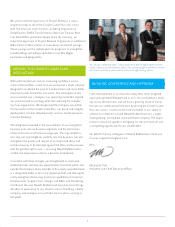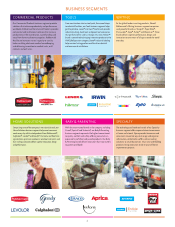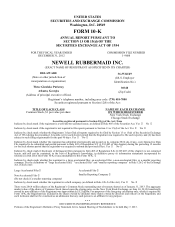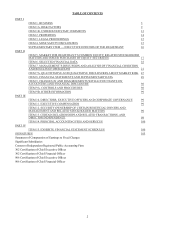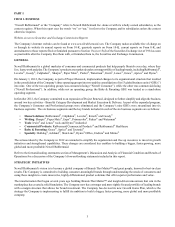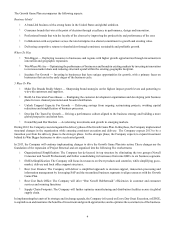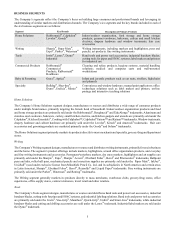Graco 2012 Annual Report Download - page 13
Download and view the complete annual report
Please find page 13 of the 2012 Graco annual report below. You can navigate through the pages in the report by either clicking on the pages listed below, or by using the keyword search tool below to find specific information within the annual report.7
to improve product presentation, optimize display space for both sales and income, and encourage impulse buying by retail
consumers.
Customer Marketing and Service
The Company strives to develop long-term, mutually beneficial partnerships with its customers and to be their supplier and brand
of choice. To achieve this goal, the Company has a value-added marketing program that offers a family of leading brand name
consumer products, tailored sales programs, innovative merchandising support, in-store services and responsive top management.
The Company strives to enhance its relationships with customers through exceptional customer service. The Company’s ability
to provide superior customer service is a result of its supply chain, information technology, and marketing and merchandising
programs that are designed to enhance the sales and profitability of its customers and provide consistent on-time delivery of its
products.
A critical element of the Company’s customer service is consistent on-time delivery of products to its customers. Retailers are
pursuing a number of strategies to deliver the highest-quality, best-cost products to their customers. Retailers frequently purchase
on a “just-in-time” basis in order to reduce inventory carrying costs and increase returns on investment. As retailers shorten their
lead times for orders, manufacturers and suppliers need to more closely anticipate consumer buying patterns. The Company
supports its retail customers’ “just-in-time” inventory strategies through more responsive manufacturing and distribution
capabilities and electronic communications.
Foreign Operations
Information regarding the Company’s 2012, 2011 and 2010 foreign operations and financial information by geographic area is
included in Footnote 19 of the Notes to Consolidated Financial Statements and is incorporated by reference herein. Information
regarding risks relating to the Company’s foreign operations is set forth in Part I, Item 1A, of this report and is incorporated by
reference herein.
The Company began accounting for its Venezuelan operations using highly inflationary accounting in January 2010. Under highly
inflationary accounting, the Company remeasures assets, liabilities, sales and expenses denominated in Bolivar Fuertes into U.S.
Dollars using the applicable exchange rate, and the resulting translation adjustments are included in earnings. In June 2010, the
Venezuelan government introduced a newly regulated foreign currency exchange system, Transaction System for Foreign Currency
Denominated Securities (“SITME”). Foreign currency exchange through SITME is allowed within a specified band of 4.5 to 5.3
Bolivar Fuerte to U.S. Dollar, but most of the exchanges have been executed at the rate of 5.3 Bolivar Fuerte to U.S. Dollar. The
Company began applying the SITME rate of 5.3 Bolivar Fuerte to U.S. Dollar in May 2010. The transition to the SITME rate
resulted in a foreign exchange gain of $5.6 million, which is recognized in other income for 2010. The SITME rate has remained
unchanged at 5.3 Bolivar Fuerte since June 2010, and consequently, there was no foreign exchange gain or loss recorded for the
Company’s Venezuelan operations during 2011 and 2012.
As of December 31, 2012, the Company’s Venezuelan subsidiary had $63.4 million of net monetary assets denominated in Bolivar
Fuertes at the SITME rate of 5.3 Bolivar Fuertes to U.S. Dollar, and as a result, a 10% increase (decrease) in the applicable exchange
rate would result in an estimated one-time pretax charge (benefit) of $6 million. On an ongoing basis, excluding the impacts of
any actions management might otherwise take in response to a change in exchange rates, such as raising or decreasing prices, a
10% increase (decrease) in the exchange rate would unfavorably (favorably) impact annual net sales and operating income by an
estimated $5 million and $3 million, respectively.
In February 2013, the exchange rate for Bolivar Fuertes declined to 6.3 Bolivar Fuertes to U.S. Dollar, and as a result, the Company
expects to record an estimated $10 million one-time charge in the first quarter of 2013, based on the decline in value of the net
monetary assets of its Venezuelan operations that are denominated in Bolivar Fuertes at the time the devaluation is effective. In
addition, the Company’s 2013 reported net sales and operating income are expected to be adversely impacted by an estimated $9
million and $5 million, respectively, due solely to the devaluation of the Bolivar Fuerte. The Company is unable to predict with
certainty whether future devaluations will occur because of the economic uncertainty in Venezuela; however, future devaluations
would adversely impact the Company’s future financial results.
Raw Materials and Sourced Finished Goods
The Company has multiple foreign and domestic sources of supply for substantially all of its material requirements. The raw
materials and various purchased components required for its products have generally been available in sufficient quantities. The
Company’s product offerings require the purchase of resin, corrugate and metals, including steel, stainless steel, zinc, aluminum
and gold. The Company’s resin purchases principally comprise polyethylene and polypropylene in roughly equal quantities. Over
the long-term, the Company has experienced inflation in raw material prices, and the Company expects continued inflation pressures




